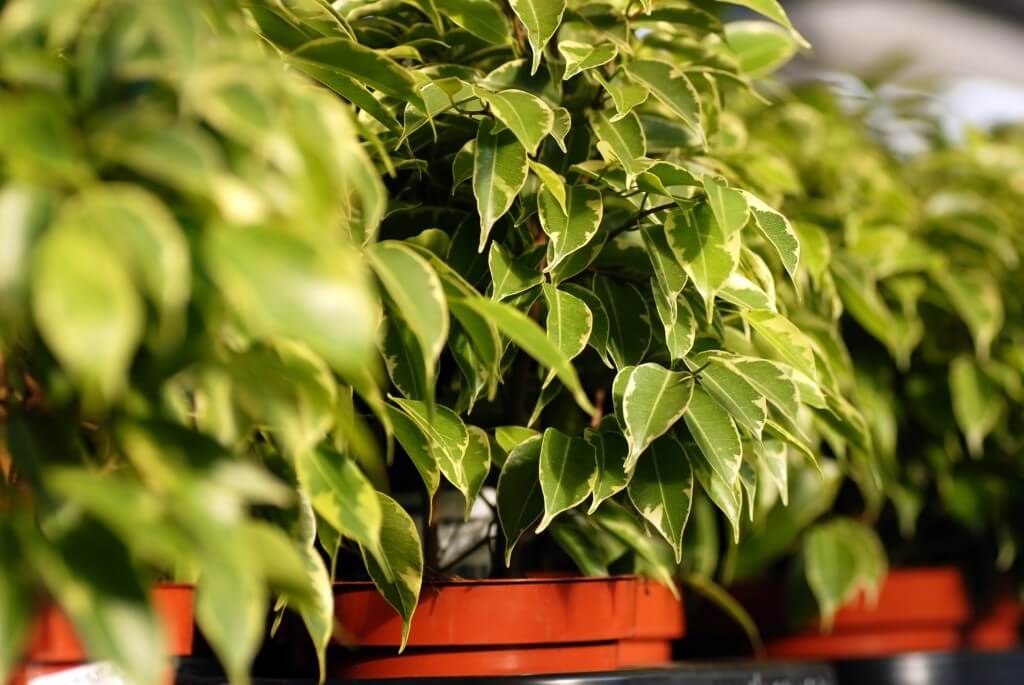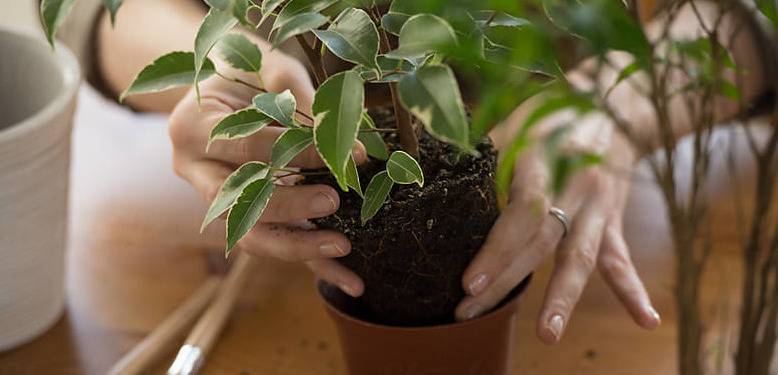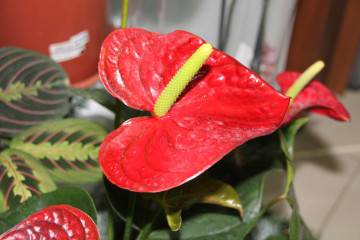Ficus Benjamin transplant at home
Content:
Ficus Benjamina is well known to fans of indoor floriculture. The unusual color of its foliage, luscious green often with white or yellowish strokes, attracts attention and sets it apart from other plants that can be grown at home. While this ficus is still quite young, its trunk has flexibility, which allows you to give it an unusual shape and even braid it. In order for this tropical plant to grow and develop well, it should be transplanted and looked after in a timely manner, while observing certain rules.
When do you need a transplant
Any plant that has a strong root system and is capable of growing to an impressive size, over time, requires transplanting into a larger pot. Otherwise, it stops growing, stops growing and renewing the crown. It is possible to determine that the time has come to transplant Benjamin's ficus by several signs:
- roots began to protrude and bulge on the surface of the soil in the pot;
- the roots do not appear on the surface, but through the drainage holes in the bottom of the pot;
- the ground has an unpleasant sour or musty smell;
- the plant looks unhealthy: it is infected with pests or there is a suspicion of decay of the root system;
- the top layer of earth in the pot began to poorly pass water during watering, quickly hardens when it dries. This suggests that the drainage qualities of the soil have worsened and additional feeding is necessary;
- it was decided to reproduce the plant.
The months from October to February cannot be considered suitable for transplanting Benjamin's ficus, since it is at this time that the plant is going through a dormant period. A favorable time for the procedure is from the beginning to the end of spring, when the flower will easily endure changes due to the beginning of the activity of natural processes.
How often to transplant Benjamin's ficus
In the first years of life, the plant grows roots and crown especially actively. Benjamin's ficus is no exception, especially since in nature it can grow into a huge tree. For this reason, a plant younger than four years old needs replanting every year: it becomes cramped in the old pot, and the soil has time to be depleted during this time. When the plant is already old enough and its growth begins to slow down, you can replant it not so often, but with an interval of 2-3 years. A completely adult ficus is transplanted even less often.
Experienced flower growers advise not to disturb adult ficuses with a transplant, so as not to injure the root system. As a rule, a plant aged six years and older is already in a rather large container - a tub or a pot, so you can limit yourself to a careful replacement of the top layer of soil.
How to choose a pot and soil
Before transplanting Benjamin's ficus at home, you need to select a suitable pot and soil in advance. When choosing a pot, it is better to give preference to a not too large capacity, 2-3 cm higher and wider than the one in which the ficus is at the time of transplantation. It is not so important what the pot will be made of, it can be ceramic, clay or plastic. Each option has its own advantages and disadvantages: natural materials absorb moisture well, but are rather heavy and fragile, plastic products are lighter, inexpensive and attract with their unusual colors.
The next step is to fill the pot with suitable soil. To begin with, drainage is placed on the bottom, ensuring the outflow of water into the sump after irrigation and good air permeability of the soil.
You can purchase a ready-made substrate or prepare it yourself. In the latter case, the following steps must be performed, including soil disinfection:
- Prepare the ingredients for the soil mixture (river sand, peat, leaf and turf soil).
- Combine both types of soil, sand and peat in a ratio of 2: 2: 1: 1.
- Dilute a solution of potassium permanganate in a separate bowl, or simply boil water.
- Spill the finished soil mixture with boiling water or potassium permanganate to destroy possible pests and pathogenic bacteria.
This procedure is required when transplanting any plants. This allows the soil to be disinfected and promotes better plant survival in new soil.
Preparation for transplanting ficus Benjamin
How well the ficus adapts and will develop in the future largely depends on the correctly selected soil composition. Ficus Benjamin is a capricious and sensitive plant, it needs soil with an acidity index in the range of 5.5-6.5 pH, otherwise it will be difficult to feed the plant, which will affect its appearance.
If you are going to transplant ficus, be sure to water it on the eve of the procedure. Then, the next day, the plant can be easily removed from the pot, along with a lump, a little damp earth without damaging the roots. It is also best to loosen the topsoil to increase the aeration of the roots and make them more pliable.
Transplant method
The ficus tree is transplanted by the transshipment method. This approach allows you to preserve the root ball and the roots of the plant themselves. There are no particular difficulties in this procedure, except that when working with a large plant, you will have to use someone's help. The transplant sequence is as follows:
- From the container in which the ficus is located, carefully remove the top layer of soil, trying not to damage the roots.
- Holding the plant by the trunk, it is shaken from side to side, separating the lump from the walls of the pot. In the case of a plastic container, if it is not too thick, the walls are crushed with hands from the outside.
- The root ball is removed from the pot, while continuing to hold the ficus by the trunk.
- Carefully examine the root system of the plant, cutting off any damaged tips found.
- A drainage layer is placed in the tub selected for planting.
- A purchased or self-made soil mixture is poured over the drainage.
- In the middle of the container, make a small depression in the ground and pour some water into it.
- The root ball is placed in the center of the tub, filling it with soil mixture along the edges and compacting the surface with your hands.
Care after plant transplant
After the transplant is completed, the ficus is not watered, the moisture that was poured in during the procedure under the root ball is enough. It is better to postpone the first watering for 2-3 days. In rooms with dry air and high temperatures, it is recommended to spray the plant crown 2 times during the day.
The tub with the plant is placed in a well-lit place, protected from a draft, avoiding direct sunlight on the foliage. For Benjamin's ficus, it is advisable to create a room temperature in the range of 20-25 ° C (for the winter, it should be reduced to 16-18 ° C).
Ficus is also not fed immediately, maintaining the intervals between procedures up to one month and gradually reducing it to two weeks. It is preferable to alternate liquid mineral and organic compounds introduced by irrigation.
Transferring from the shipping pot after purchase
A newly purchased ficus cannot be transplanted immediately, especially in winter, however, you should not delay with this. The procedure will be optimal in 2-3 weeks, after the plant appears in the house, when it has adapted to new conditions. In this case, the transplanting rules are followed by the same ones that apply to moving the plant into a larger pot.
Having acquired several young Benjamin ficuses (up to 1 year old), you can resort to the following decorative technique: plant them all in one common large tub and weave still thin, flexible trunks.
Typical transplant errors
Novice florists quite often make mistakes when transplanting Benjamin's ficus. When the plant begins to shed its leaves and looks sick, you need to find the cause of this phenomenon and eliminate it. There are such common deviations from the rules of care:
- the plant is installed in a place with inappropriate lighting;
- the ficus was transplanted into a too large tub that does not correspond to its size;
- irrigation and spraying regimes are not properly followed;
- there is no drainage layer in the planting tank;
- damaged root system;
- when replanting, a soil with an excessive acidity was used;
- the transplant was carried out at the wrong time (autumn or winter).
Home care and Benjamin ficus transplant require compliance with the above conditions and rules. If they are not neglected, then the tree will actively grow and develop, delighting the grower with a lush crown throughout the year.




















